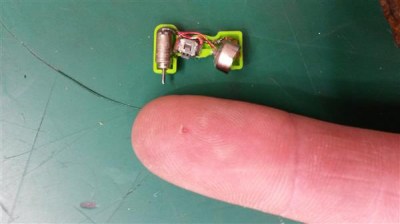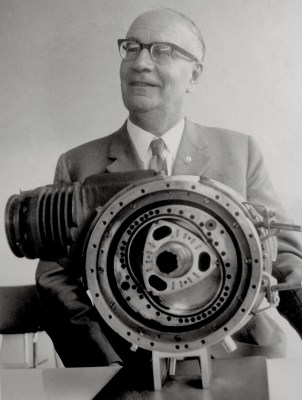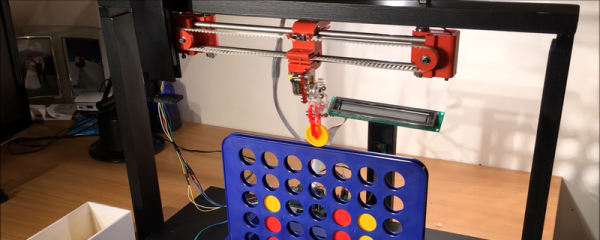Most people play games for entertainment. Hackers build robots to play games for entertainment. That’s what [piandchips] did. He used a Raspberry Pi and a MeArm kit to build a Connect 4-playing robot. The robot–named 4-Bot–has to do two things: the first is it has to be able to manipulate the pieces. Secondly, it has to be able to see the board. The MeArm imbues 4-Bot with the manipulation ability, and a clever scanning system does the trick.
Day: March 3, 2016
World’s Smallest Cordless Power Tools, 3D Printed Of Course
What is this? A circular saw for ants?!
There isn’t much information we could find on this one (sorry, no source files that we know of), but this little hack is so playful and fun, we just had to share it with you. [Lance Abernethy] has built both a working cordless drill, and circular saw using nothing more than a 3D printer, what seems to be a pager-type vibration motor, a tactile switch and a coin cell battery – you can see them both working in the video after the break.

[Lance] used an Ultimaker 2, running a 0.25mm nozzle, and printing at a 0.04mm layer height in PLA. As you would expect, the 0.25mm nozzle is needed for such small parts – it’s also close to the limit of what extruder can still squeeze plastic through. it greatly increases the chance of blocked or clogged nozzles.
[Lance] admits that the saw can’t quite cut anything just yet, but he does say that he has plans to make more miniature cordless tools. We can’t wait to see how he might manage the mechanism for a jig-saw.
[VIA adafruitdaily.com newsletter]
Continue reading “World’s Smallest Cordless Power Tools, 3D Printed Of Course”
Get Really Basic With Steppers And Eight Buttons
[Kevin Darrah] put together a good video showing how to control a stepper motor with, not a motor driver, but our fingers. Taking the really low-level approach to do this sort of thing gave us a much better understanding about the features of our stepper driver chips. Such as, for example, why a half step needed twice the current to operate.
[Kevin] starts with the standard explanation of coils, transistors, and magnets that every stepper tutorial does. When he hooks up simple breadboard with passives and buttons, and then begins to activate the switches in sequence is when we had our, “oh,” moment. At first even he has trouble remembering the correct sequence, but the stepper control became intuitive when laid out with tactile switches.
We set-up our own experiment to see if we remembered our lessons on the subject. It was a fun way to review what we already knew, and we learned some more along the way. Video after the break.
Continue reading “Get Really Basic With Steppers And Eight Buttons”
Etching PCBs With A 3D Printer
With the coming of very cheap blue laser diodes, PCB fabrication has become increasingly interesting. Instead of making a photoresist, placing it over a piece of pre-sensitized copper clad board, and putting the whole assemblage under a blacklight, it’s possible to put a photomask on a board with a tiny bit of very blue light. All you need is a CNC machine. A 3D printer can be a very precise CNC machine, and when you combine these two ideas together, you can make printed circuit boards with an Ultimaker.
[Geggo] had the idea of attaching a blue laser diode to his Ultimaker to burn a few traces into presensitized copper board. With a 3D printed adapter, he was able to mount the diode and associated electronics right on the extruder body. With a small ring to tighten up the aperture, [geggo] was able to put a 50 micrometer wide dot of light on a piece of copper. The laser is powered directly from the PWM fan output on the printer controller board, allowing this entire mish-mash of cheap electronics to be controlled via G-code.
A few experiments were necessary to determine the correct speeds and power settings, with the best results being 1000 mm per minute at 40 mA. The finished board looks fantastic, and a few minutes after [geggo] was done etching a board, he started using his 3D printer as a printer. It’s a result that is so good, so easy to accomplish, and requires so little effort it makes us wonder why we don’t see more of this.
Materials To Know: Acetal And Delrin
Delrin, Acetal, and its many trade names is a material properly known as Polyoxymethylene or POM. It is one of the strongest plastics and is a good go-to material when you want the best properties of plastic, and don’t need the full strength of a metal part. It was originally formulated to compete with Zinc and Aluminum castings after all.
I won’t go too deep into the numbers behind POM. If you need the Young’s Modulus, you probably don’t need this guide. This is intended to be more of a guide to its general properties. When you’re looking for something to fit an application it is usually easier to shift through the surface properties to select a few candidates, and then break the calculator out later to make sure it will work if you’re uncertain about the factor of safety.
The most popular property of POM is its ease of machining. While doing this research every single site I came across referred to it as the most machinable plastic. That’s about as objective as subjective praise can get. It doesn’t tend to grab tools like, for example, HDPE. It also chips nicely unlike UHMW and Nylon. Some plastics, like UHMW, have the unfortunate tendency to render the dials on a mill or lathe meaningless as the plastic deflects away from the tool. POM does not do this as much. Of course these other plastics have their strengths as well, but if any plastic will do, and you’re machining, POM is a very good choice.
Swarm Of Tiny Pirate Transmitters Gets The Message Out In Syria
They say that the first casualty of war is the truth, and that’s probably only more the case in a civil war. When one side in a conflict controls the message, the other side is at a huge disadvantage. Technology can level the playing field, and in the case of the Syrian Civil War, a swarm of tiny Raspberry Pi transmitters is helping one side get their message out.
We won’t pretend to understand the complexities of this war, but it’s clear that the Syrian government controls broadcast media and access to the internet, and is using them for propaganda while denying the opposition access to the same. A decentralized medium can get the message out under these conditions, and that’s exactly what Pocket FM does. Built around a Raspberry Pi and a frequency-agile FM transmitter, a Pocket FM can take multiple audio feeds and transmit them out to a 5km radius. Small enough to be packed up and deployed quickly and able to be powered by batteries or solar panels, the pirate transmitters can be here one minute and gone the next, yielding a robust network resistant to takedown attempts.
The network built around Pocket FM in Syria is small but growing, and it appears to be making a difference in the conflict. We find the concept of a decentralized network intriguing and potentially empowering, at least in situations where the letter of the law regarding broadcasting is not a prime consideration. That’s where projects like Airchat seek to build an unsanctioned network. The same goes for Tweeting on the Amateur Radio Band in a project aptly named HamRadioTweets.
We wonder how a fleet of these Pi-based transmitters could aid in recovery from natural disasters?
[via r/amateurradio and TomHiggins]
Broken Promises Of The Wankel Engine
Through the history of internal combustion engines, there has been plenty of evolution, but few revolutions. Talk of radically different designs always leads to a single name – Wankel. The Wankel rotary engine, most notably used in automobiles by Mazda, has been around since the late 1950’s. The Wankel rotary is an example of a design which makes sense on paper. However, practical problems cause it to underperform in the real world.
Invention and History
 Felix Wankel’s engine was conceived during a dream. In it, 17-year-old Felix was driving his car to a concert. When he arrived, he bragged to his friends that his car used a new type of engine – half turbine, half reciprocating. “It is my invention!” he told his friends. Upon waking up, Wankel became dedicated to building his engine. Though he never received a formal degree (or a driver’s license), Wankel was a gifted engineer.
Felix Wankel’s engine was conceived during a dream. In it, 17-year-old Felix was driving his car to a concert. When he arrived, he bragged to his friends that his car used a new type of engine – half turbine, half reciprocating. “It is my invention!” he told his friends. Upon waking up, Wankel became dedicated to building his engine. Though he never received a formal degree (or a driver’s license), Wankel was a gifted engineer.
Young Wankel’s checkered history includes membership in several anti-semitic groups in the 1920’s. He was also involved with the founding of the Nazi party. His conflicting views on the direction of the party lead to his arrest in 1933. Eventually released through action of Hitler himself, Wankel joined the SS in 1940. The end of the war saw Wankel spending several months in a French prison for his wartime involvement.


















